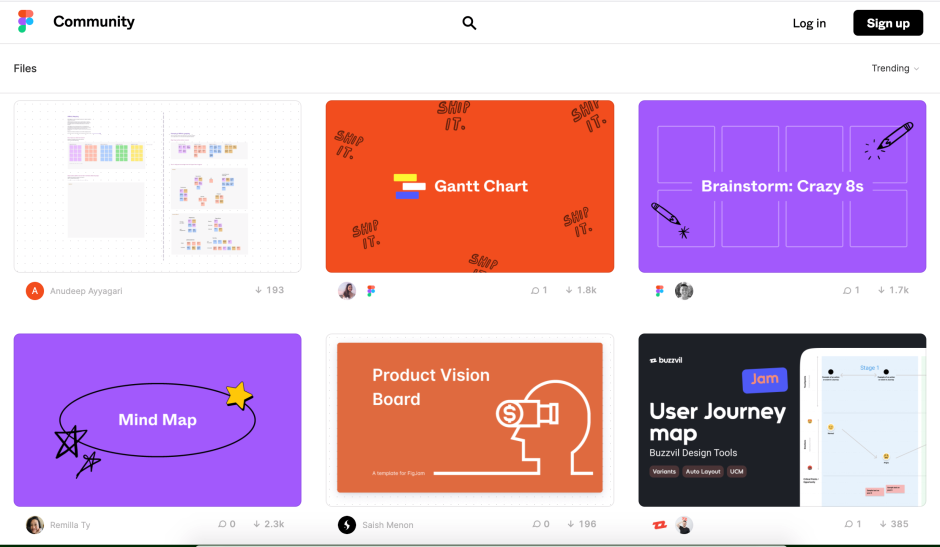Figma says it has the answer to lackluster brainstorming meetings

Not another brainstorming meeting.
Despite mounting evidence suggesting the futility of crowdsourcing creativity, the impulse to gather a team to kick around ideas remains an unassailable corporate ritual. Some experts believe that these types of open-ended meetings are better done virtually, but that isn’t exactly conclusive given the various distractions associated with working remotely. Who among us has not experienced a Zoom grid of awkward silence during a virtual brainstorm?
Figma, the developer of accessible, web-based design software, contends that there have been two key ingredients missing from typical brainstorming sessions: playfulness and parity. Its new virtual whiteboard, called Figjam, comes with interactive features designed to bring these elements back to meetings.
Dylan Field, the company’s co-founder and CEO, says he saw the clamor for a whiteboard tool came after watching Figma users hack their software to create their own collaboration spaces. Because Figma embraces the “multi-player” ethos, where several parties can create a design together on the fly, it already had built-in communication channels for remote teams to collaborate easily.


Flowchart flow state.
Figjam, Field explains, is a simplified version of those user-created environments. “We just really want to create the best experience so teams can enter a flow state and just be creative together,” he tells Quartz. “Our objective was to create a very intuitive tool that’s also super fun to use.”
Launched at Figma’s annual conference in April, Figjam is currently available for free until the end of the year. Teams at Facebook, Microsoft, and Netflix are already using it, Field says.
The fun factor
Play is the system’s guiding design principle. “I think that when we’re in a state of play, we’re able to think more creatively, which often improves whatever work we’re doing,” says Field.
Figjam includes elements like colorful sticky notes, stamps, stickers, emoji-style prompts, and a “cursor chat” option for typing in quick comments. A voice chat function will be introduced so that team members can talk through ideas while looking at their virtual whiteboard together. “We went with audio very intentionally instead of video because I think audio somehow involves less ego,” explains Field. “It’s a different resonance in terms of how it affects the brainstorm.” Figjam also has a robust diagramming feature for those who like to think in terms of systems and processes.
Brian Stegall, who leads a 25-person design team at Square, tells Quartz that the flowchart function and the interactive brainstorming features have been crowd pleasers. “We were previously doing this [brainstorming] in Google spreadsheets which was a pain,” he says. “Having everyone in there to comment and move things around was useful. The team loved it and felt that the meeting was super productive and also fun. They wanted to do it again; they wanted to do it more.”
Kevin Wilson, head of product design at the messaging app Discord, says Figjam has been a viable replacement for the in-person sessions his team used to do at their San Francisco office. The pared down, intuitive interface allow non-designers to easily participate. “In giving you less [in terms of features], it gives you more clarity to focus on what you’re working on,” he says. While there are other robust online whiteboard options like Miro or Mural, many designers who already use Figma have been drawn to Figjam because it integrates seamlessly with their systems.
Online games for remote building
In search of better, more novel collaboration tools, Stegall and Wilson have observed that users have been experimenting with various online platforms outside of their original intent. Stegall is particularly fond of all the ways designers have hacked Figma or Figjam to create their own software. Among his favorites is an “Escape the Room” game, which several groups at Square have used as an online team-building exercise during the pandemic.
Last month, I wrote and illustrated an escape room in @figmadesign for my friends to play, and I've finally published it!!
Play the Mystery of Everson Manor, a fully virtual escape room adventure: https://t.co/sXXyxUUlSq
— ace
(@pigeonerTM) October 16, 2020
“We didn’t sign on for Figma for the fun factor, but it’s been a good bonus,” Square’s Stegall says.

Figjam user-generated templates
Similarly, Discord, a chat app originally designed for online gaming communities, has seeped into schools and other online groups, Wilson explains. “We’re no Zoom, but we’ve doubled our user base and tripled our revenue,” he says. “It’s cool to see so many people discover us in 2020 and we’re just trying to catch up now with all that growth. We’re doubling our design team this year and that will require more collaboration for sure.”
No doubt that’s the kind of opportunity that Figma should start brainstorming how to serve.
Sign up for the Quartz Daily Brief, our free daily newsletter with the world’s most important and interesting news.
More stories from Quartz:
The death counters: How journalists in Narendra Modi’s home state exposed India’s Covid-19 deception
